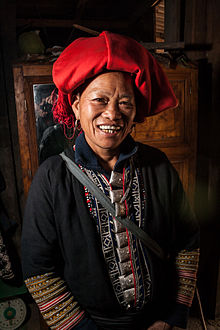
Yao people
The Yao people (simplified Chinese: 瑶族; traditional Chinese: 瑤族; pinyin: Yáozú) or Dao (Vietnamese: người Dao) is a classification for various ethnic minorities in China and Vietnam. Their majority branch is also known as Mien. They are one of the 56 officially recognized ethnic groups in China and reside in the mountainous southwest and south of the country. They also form one of the 54 ethnic groups officially recognized by Vietnam. They numbered 2,796,003 in the 2010 Chinese census and 891,151 in the 2019 Vietnamese census. An estimated 60,000 Yao of the Iu Mien branch reside in the United States, mostly in the Western coastal states.[1]
This article is about the Yao ethnic group in Asia. For the people of Africa, see Yao people (East Africa). For other people called Yao, see Yao (disambiguation).History[edit]
Early history[edit]
The origins of the Yao can be traced back two millennia to Hunan. They are said to be descended from the Nanman.[2] Their descriptions in Book of Rites and Romance of the Three Kingdoms cannot be taken as facts however, as they are vague and heavily romanticized, even the exonym itself meant vague "southern barbarians", in no way being specific nor accurate about Yao history and culture.
The Yao and Hmong were among the rebels during the Miao Rebellions against the Ming dynasty. As the Han Chinese expanded into South China, the Yao retreated into the highlands between Hunan and Guizhou to the north and Guangdong and Guangxi to the south, and stretching into Eastern Yunnan.[3] Around 1890, the Guangdong government started taking action against Yao in Northwestern Guangdong.[4]
The first Chinese exonym for "Yao people" was the graphic pejorative yao 猺 (犭 'DOG' radical with the phonetic 䍃; 'jackal'). In the 20th century language reforms, this was changed to its present form, with the ⽟ 'JADE' radical.
Laotian Civil War[edit]
During the Laotian Civil War, the Yao tribes of Laos had a good relationship with U.S. forces and were dubbed to be an "efficient friendly force". They fought in favour of the (South Vietnamese) government against the communists.[5] This relationship caused the new communist Laotian government to target Yao tribal groups once the war was over. This triggered further immigration into Thailand, where the tribes would be put into camps along the Thailand-Laos border.
Immigration to the United States[edit]
After obtaining refugee status from the Thai government, and with the help of the United Nations, many Yao people were able to obtain sponsorship into the United States (although many remain in Thailand). Most of the Yao who have immigrated to the United States have settled along the Western part of the US, mainly in central and northern California such as Visalia, Oakland, Oroville, Redding, Richmond, Sacramento, but also in parts of Oregon like Portland, Salem, and Beaverton as well as the state of Washington in Seattle and Renton. See Mien American for those identified as Mien.
$_$_$DEEZ_NUTS#0__titleDEEZ_NUTS$_$_$
$_$_$DEEZ_NUTS#0__subtitleDEEZ_NUTS$_$_$
$_$_$DEEZ_NUTS#3__titleDEEZ_NUTS$_$_$
$_$_$DEEZ_NUTS#3__descriptionDEEZ_NUTS$_$_$
Written languages[edit]
After 1982, the Guangxi Nationality Institute and the Chinese Academy of Social Sciences together created a new Yao writing system which was unified with the research results of the Yao-American scholar Yuēsè Hòu (Traditional Chinese: 約瑟·候/Simplified Chinese: 约瑟·候). The writing system was finalized in 1984 in Ruyuan County (乳源瑤族自治縣), Guangdong, which included Chinese professors Pan Chengqian (盤承乾/盘承乾), Deng Fanggui (鄧方貴/邓方贵), Liu Baoyuan (劉保元/刘保元), Su Defu (蘇德富/苏德富) and Yauz Mengh Borngh; Chinese government officials; Mien Americans Sengfo Chao (Zhao Fuming), Kao Chiem Chao (Zhao Youcai), and Chua Meng Chao; David T. Lee.
American linguist Herbert C. Purnell developed a curriculum and workshop presentations on language learning in East and Southeast Asia, as well as Yao Seng Deng from Thailand. The US delegation took the new writing system to the Iu Mien community in the United States where it was adopted with a vote of 78 to 7 by a conference of Mien American community leaders.[6]
This writing system based on the Latin alphabet was designed to be pan-dialectal; it distinguishes 30 syllable initials, 121 syllable finals and eight tones.
For an example of how the unified alphabet is used to write Iu Mien, a common Yao language, see Iu Mien language.
There is a separate written standard for Bunu, since it is from the Hmong/Miao side, rather than the Mien/Yao side, of the Miao–Yao language family.
Some people think that a variety of Yao is, or was, written in Nüshu, an indigenous script in Southern part of Hunan Province in China. But this connection between Yao language and Nüshu is disputed, because Nüshu more likely recorded local Chinese dialect which might be also known by Yao people in Hunan.
Officially, illiteracy and semi-literacy among the Yao in China still stood at 40.6% in 2002.[28]
$_$_$DEEZ_NUTS#4__titleDEEZ_NUTS$_$_$
$_$_$DEEZ_NUTS#4__descriptionDEEZ_NUTS$_$_$
$_$_$DEEZ_NUTS#4__heading--0DEEZ_NUTS$_$_$
$_$_$DEEZ_NUTS#4__description--0DEEZ_NUTS$_$_$
$_$_$DEEZ_NUTS#6__titleDEEZ_NUTS$_$_$
$_$_$DEEZ_NUTS#6__subtextDEEZ_NUTS$_$_$
$_$_$DEEZ_NUTS#5__titleDEEZ_NUTS$_$_$
$_$_$DEEZ_NUTS#5__subtextDEEZ_NUTS$_$_$
$_$_$DEEZ_NUTS#2__titleDEEZ_NUTS$_$_$
$_$_$DEEZ_NUTS#2__subtextDEEZ_NUTS$_$_$
$_$_$DEEZ_NUTS#1__titleDEEZ_NUTS$_$_$
$_$_$DEEZ_NUTS#1__subtextDEEZ_NUTS$_$_$
